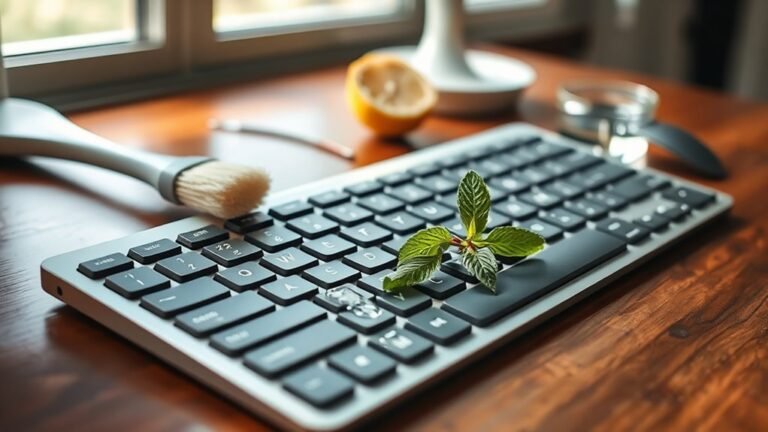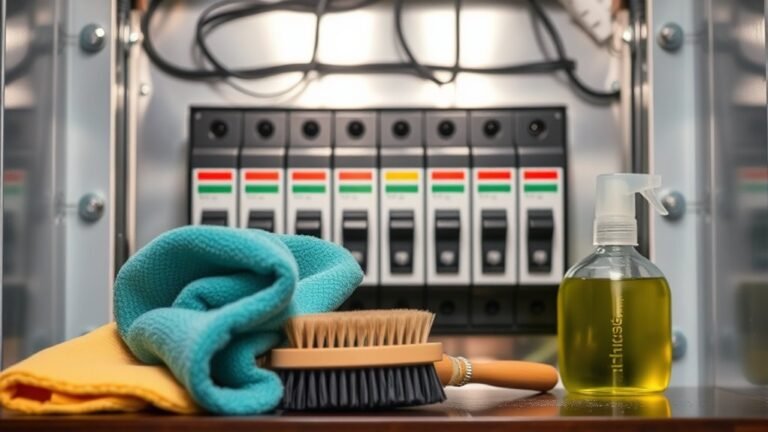Essential Tools for Cleaning Smartphone
To keep your smartphone spotless and safe, you’ll want microfiber cloths for gentle, scratch-free cleaning and isopropyl alcohol solutions around 70% for disinfecting without damage. Soft bristle brushes help clear tiny crevices, while compressed air canisters remove dust from ports safely. Screen cleaning sprays tackle fingerprints, and cotton swabs or anti-static wipes reach tricky spots. These essentials balance effectiveness and care, ensuring your device looks and works great. Stick around to find out how each tool plays its part.
Microfiber Cloths

Although you might overlook them, microfiber cloths are essential for safely cleaning your smartphone’s screen without causing scratches. When choosing the right microfiber types, you’ll want one that balances softness and durability. Some cloths are designed with finer fibers, offering superior cleaning efficiency by trapping dust and oils without spreading them around. Others may be thicker, providing a bit more cushion but potentially less precision. Using the right microfiber cloth means you can wipe away fingerprints and smudges effortlessly, preserving screen clarity and your freedom to enjoy an unblemished display. Avoid harsh materials that risk damaging your device; instead, rely on these specialized cloths to keep your smartphone clean, allowing you to stay connected without compromise.
Isopropyl Alcohol Solutions
Isopropyl alcohol solutions are a powerful option for disinfecting your smartphone without damaging its delicate components. When you want a quick, effective clean that wipes out germs and oils, isopropyl alcohol delivers superior cleaning effectiveness. Just make certain to use a solution with around 70% concentration—strong enough to disinfect but gentle enough not to harm your screen or casing. Apply it sparingly on a microfiber cloth rather than directly on your device to avoid moisture seeping inside. This approach lets you reclaim control over your phone’s hygiene, giving you freedom from worries about bacteria or sticky residue. Using isopropyl alcohol solutions smartly guarantees your smartphone stays spotless and safe, ready for whatever your day demands.
Soft Bristle Brushes

A soft bristle brush is a handy tool for reaching the tiny crevices and edges of your smartphone that cloths can’t access. When choosing bristle brush types, opt for gentle nylon or natural bristles to avoid scratching your device. Mastering cleaning brush techniques, like light sweeping motions, helps dislodge dust without pushing it deeper. Use the brush dry or slightly dampened with isopropyl alcohol for stubborn grime.
| Bristle Brush Types | Cleaning Brush Techniques |
|---|---|
| Nylon | Gentle circular strokes |
| Natural | Light sweeping motions |
| Silicone | Targeted edge cleaning |
These brushes offer freedom to clean precisely, keeping your smartphone pristine without harsh chemicals or risky tools.
Compressed Air Canisters
Two quick bursts from a compressed air canister can blast away dust and debris stuck in your smartphone’s ports and crevices. You’ll find compressed air uses incredibly effective for reaching spots brushes can’t, freeing your device from buildup without opening it up. To keep this tool working safely and efficiently, proper handling is key: always hold the can upright to prevent liquid propellant from spraying, and use short bursts to avoid moisture damage. Avoid shaking the can before use, and never use compressed air near open flames or heat sources. By mastering these simple steps, you maintain your smartphone’s performance and extend its lifespan, all while enjoying the freedom of keeping your device clean and functional on your own terms.
Screen Cleaning Sprays

When it comes to cleaning your smartphone screen, choosing the right spray makes a big difference. You’ll want to know which types are safe to use and how to apply them properly to avoid damage. Using screen cleaning sprays not only keeps your display spotless but also helps protect it from smudges and germs.
Types of Cleaning Sprays
Screen cleaning sprays come in various formulas designed to tackle fingerprints, smudges, and bacteria without damaging your smartphone’s delicate surface. You can choose from commercial options that offer quick, streak-free cleaning or opt for eco friendly options that prioritize your health and the planet. If you prefer control over ingredients, homemade cleaners are a fantastic choice, often using simple mixtures like diluted vinegar or isopropyl alcohol with water. These DIY sprays let you avoid harsh chemicals, giving you freedom in how you care for your device. Whether you pick a store-bought product or whip up your own, it’s important to select a spray that’s safe for screens to maintain clarity and protect coatings. Your smartphone deserves a clean that’s both effective and gentle.
Safe Usage Tips
Choosing the right cleaning spray is just the start; knowing how to use it properly guarantees your smartphone stays safe and spotless. Always remove your protective cases before cleaning, so sprays don’t seep into crevices. Limit your cleaning frequency to avoid damaging screen coatings—once or twice a week is plenty for most users. Spray the cleaner on a microfiber cloth, not directly on your phone, to prevent liquid damage.
| Tip | Why it Matters | Quick Reminder |
|---|---|---|
| Remove Cases | Prevents moisture trapping | Take off before cleaning |
| Spray on Cloth | Avoids liquid damage | Never spray directly |
| Moderate Cleaning | Protects screen coatings | Clean 1-2 times weekly |
Benefits of Spray Cleaners
Although there are many cleaning methods out there, spray cleaners stand out because they’re specifically designed to be gentle yet effective on your smartphone’s screen. You want a tool that respects your device’s delicate surface without sacrificing cleanliness. Spray cleaner effectiveness lies in its ability to dissolve oils, fingerprints, and smudges without harsh chemicals. Plus, many options now embrace natural cleaning alternatives, letting you keep your gadget spotless while minimizing exposure to synthetic substances. This means you get a safe, eco-friendly clean that doesn’t compromise on performance. Using spray cleaners gives you the freedom to maintain your phone’s clarity and hygiene effortlessly, so you can focus on what matters without worrying about damaging your screen. It’s a smart choice for anyone valuing both device care and personal health.
Cotton Swabs
A couple of cotton swabs can make a big difference when cleaning your smartphone’s hard-to-reach spots. You’ll find they’re perfect for getting into tiny crevices like charging ports and speaker grills. But if you’re seeking cotton swab alternatives, consider reusable silicone swabs—they offer a safer, eco-friendly option that won’t shed fibers or damage delicate components. When using traditional cotton swabs, remember cotton swab safety: avoid pressing too hard or inserting them deeply to prevent harm to your device. Also, don’t use swabs soaked in harsh chemicals; a lightly dampened tip with a gentle cleaner is best. Embracing these tools thoughtfully lets you keep your smartphone spotless without compromising its integrity or your freedom to maintain it yourself.
Anti-Static Cleaning Wipes
Two or three anti-static cleaning wipes can quickly refresh your smartphone’s screen and body without leaving streaks or residue. These wipes combine cleaning effectiveness with anti static properties, preventing dust from clinging back after you wipe. Using them means less hassle and more freedom to enjoy a spotless device.
| Feature | Benefit |
|---|---|
| Anti static properties | Reduces dust attraction |
| Cleaning effectiveness | Removes smudges & oils |
| Easy to use | Convenient and mess-free |
| Portable | Clean anywhere, anytime |
You’ll appreciate how these wipes keep your phone clean longer, letting you focus on what matters. Just grab a wipe, glide it over your screen, and feel the difference—freedom from fingerprints and static cling included.
Frequently Asked Questions
Can I Clean My Smartphone With Household Vinegar?
You might think vinegar solutions are a quick fix for smartphone maintenance, but it’s best to avoid them. Vinegar is acidic and can damage your phone’s protective coatings, leading to screen dullness or even corrosion. If you want to keep your device clean without risking harm, stick to safer options like diluted isopropyl alcohol or specialized wipes. That way, you’re free to maintain your phone without worry.
How Often Should I Clean My Phone to Avoid Damage?
They say, “An ounce of prevention is worth a pound of cure,” and that’s true for your phone too. You should aim for daily cleaning to keep germs at bay and guarantee smooth phone maintenance. Wiping your device gently every day helps prevent buildup without causing damage. Just be sure not to overdo it—too much moisture or harsh chemicals can harm your phone. Keep it simple and consistent for freedom from worries!
Are UV Sanitizers Effective for Disinfecting Smartphones?
You might wonder about UV effectiveness for disinfecting smartphones. UV sanitizers can be pretty effective at killing smartphone bacteria without using chemicals, giving you a hands-off way to keep your device clean. However, they don’t remove dirt or grime, so you’ll still need to clean physically sometimes. If you want freedom from harsh cleaners and a quick sanitize, UV sanitizers are a solid option, but don’t rely on them alone.
Is It Safe to Clean My Phone While It’s Charging?
Imagine juggling fire while dancing — that’s what cleaning your phone while it’s charging can feel like. You might think it’s harmless, but charging hazards lurk in the shadows. It’s best to unplug first, then use gentle cleaning techniques like a microfiber cloth and isopropyl alcohol. This way, you avoid risks and keep your freedom to use your phone safely, without a shocking surprise interrupting your day.
What Should I Avoid When Cleaning My Smartphone Screen?
When cleaning your smartphone screen, you should avoid harsh chemicals or abrasive materials since they can damage the display. Don’t use paper towels or rough cloths; instead, stick to microfiber cloths that won’t scratch. Avoid spraying cleaning solutions directly on the screen—spray them on the cloth first. This way, you keep your screen safe and enjoy the freedom of a clean, clear display without risking damage.






